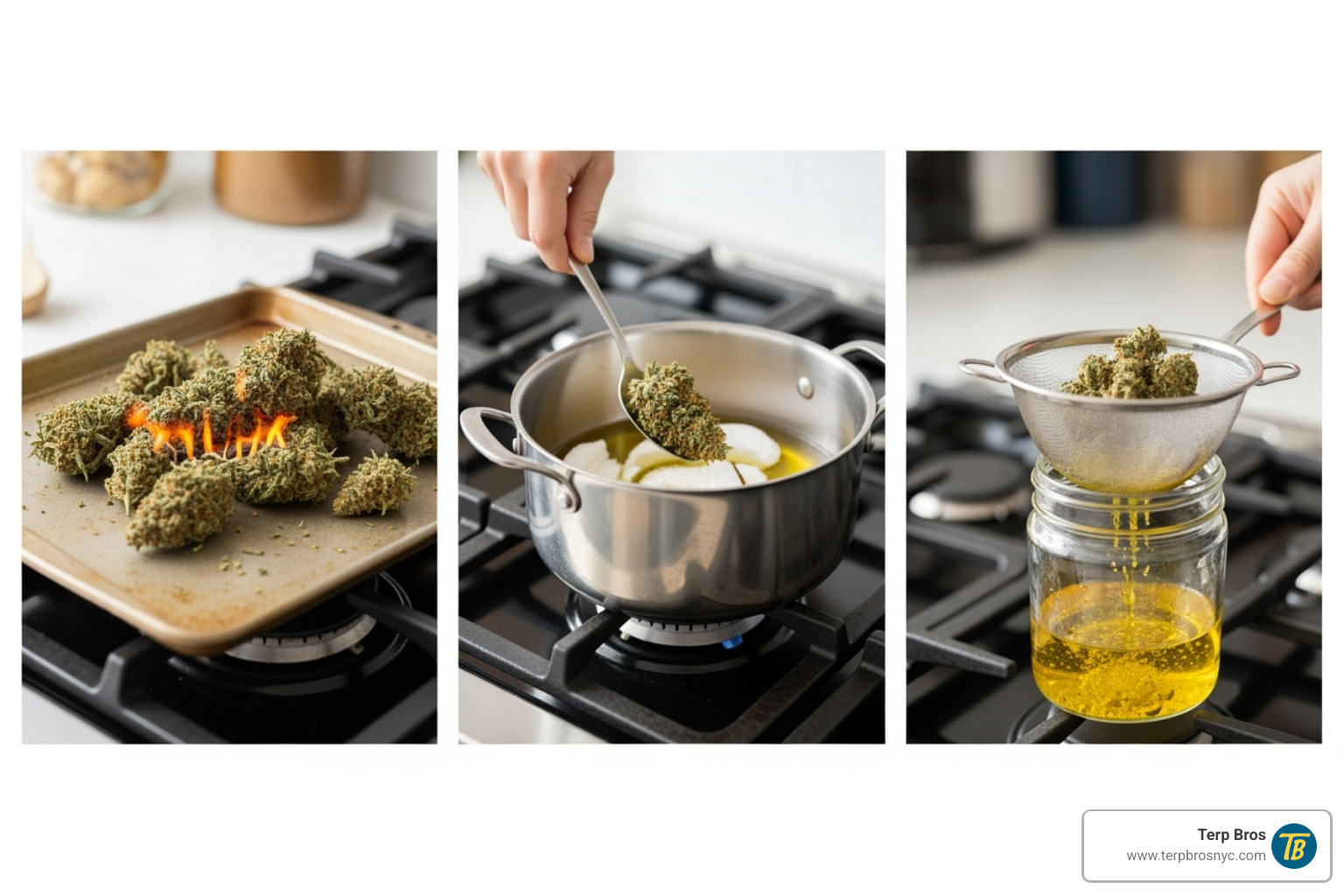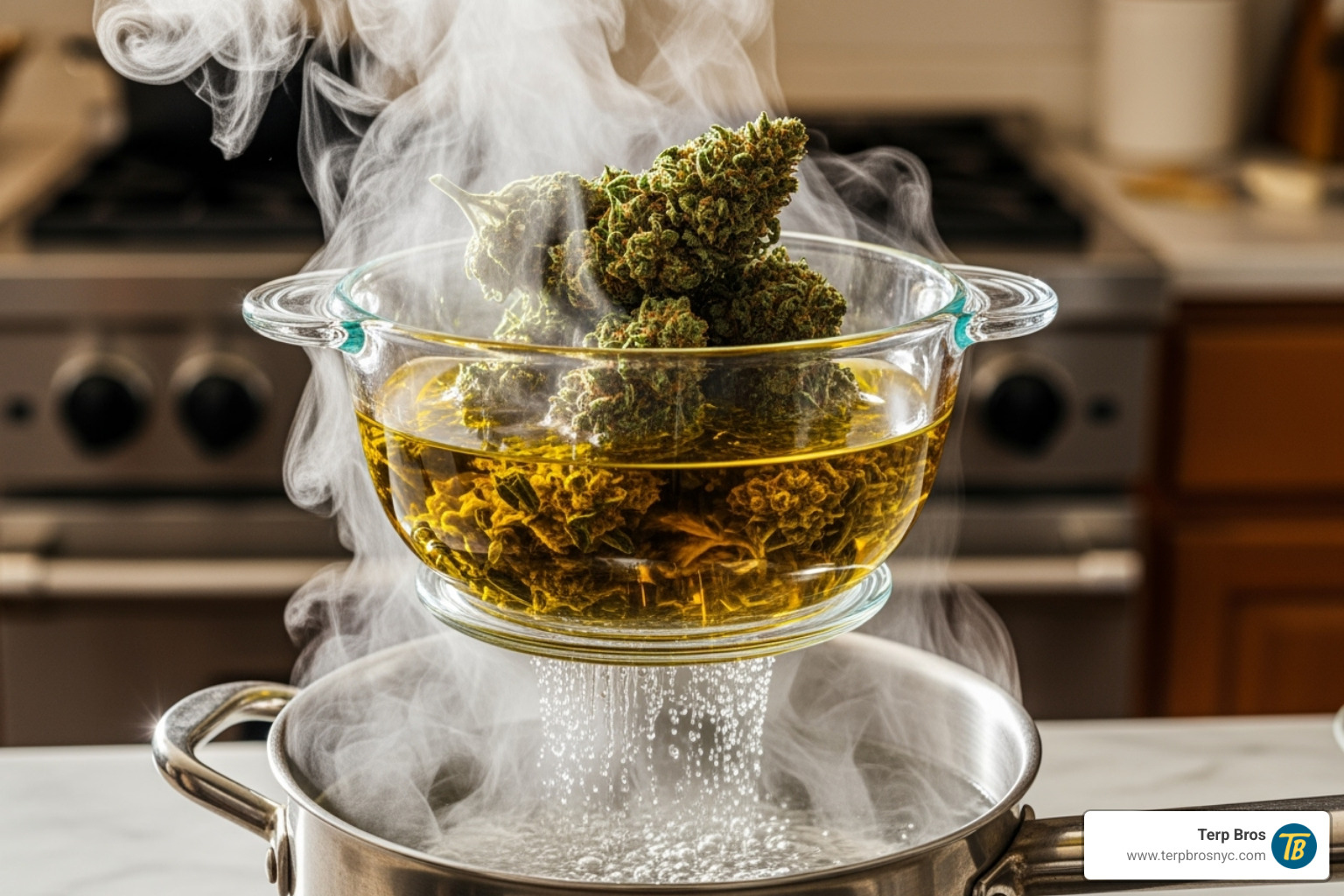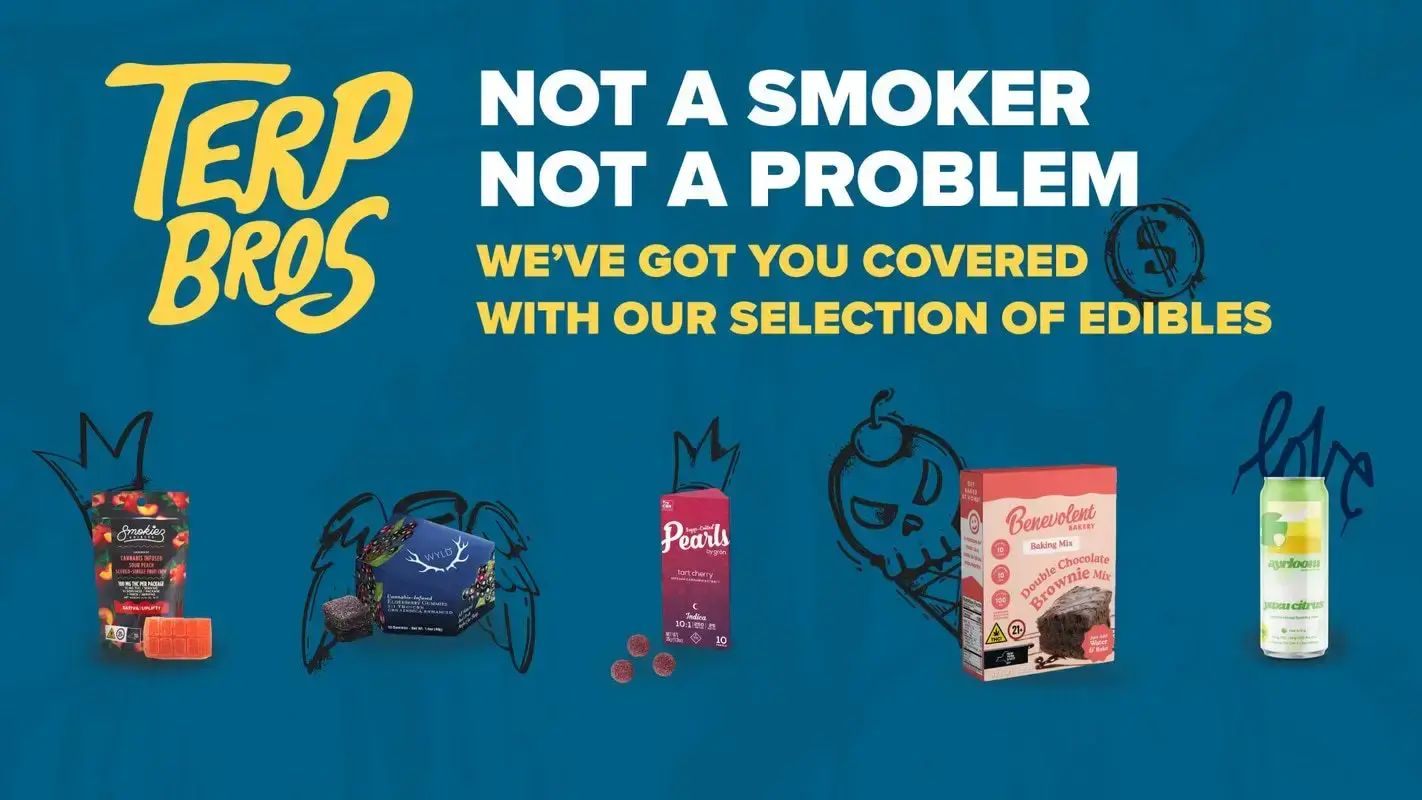how to make cannabis oil for edibles: Perfect 3 Steps
Your Gateway to Homemade Edibles
To help visualize the journey of changing raw cannabis into potent oil, we’ve created a simple infographic outlining the three main stages:

The Foundation: Prepping Your Key Ingredients

Before we start cooking, let’s get to know the true stars of our show: your cannabis and your chosen carrier oil. The real magic of how to make cannabis oil for edibles comes from how these two work together. Cannabis has special compounds called cannabinoids, like THC and CBD. These compounds are fat-soluble. This means they love fat! They need to connect with fat molecules to be properly absorbed by your body.
Choosing the right oil and getting your cannabis ready are super important first steps. They directly affect how strong your oil will be, how it tastes, and its overall quality. Think of it as building a strong foundation for your delicious creations!
Why is Decarboxylation the Most Important Step?
Ever wondered why simply munching on raw cannabis doesn’t get you high? It’s a common question! The secret is a vital process called decarboxylation, or “decarbing” for short. Raw cannabis flower holds cannabinoids in their “sleepy” forms. These are mainly THCA (tetrahydrocannabinolic acid) and CBDA (cannabidiolic acid). These acidic forms aren’t intoxicating, meaning they won’t give you the effects you’re looking for.
Decarboxylation is all about using heat to “wake up” these compounds. THCA turns into THC (the one that causes the “high”), and CBDA changes into CBD. Without this crucial step, your homemade cannabis oil won’t have much potency. It would be like trying to enjoy coffee without brewing the beans – you have the ingredients, but not the desired outcome!
The good news is that decarbing is quite simple. We’ll use your oven for this. It’s a great way to activate your cannabinoids. The trick is to use a low and steady temperature. This activates the compounds without burning off delicate terpenes (which give cannabis its amazing smell and flavor) or the cannabinoids themselves. Aim for oven temperatures between 220°F (104°C) and 245°F (118°C), baking for about 30 to 45 minutes. This gentle heat ensures everything converts perfectly, setting the stage for a potent infusion.
Choosing the Right Carrier Oil for Your Infusion
Your carrier oil isn’t just a way to move your cannabinoids around; it’s an active helper in the infusion process. Since cannabinoids love fat, they happily bind to the fats in your chosen oil. Generally, the more fat an oil has, the better it will absorb those precious compounds.
Here are some of the best oils for infusing cannabis, each with its own perks:
- Coconut Oil: Many consider this the top choice for cannabis infusions. It’s packed with saturated fat, especially medium-chain triglycerides (MCTs). MCTs are easy for your body to process, which can mean faster and better absorption of cannabinoids. Coconut oil is also super versatile – great for both sweet and savory dishes, and even for topical use. Its strong flavor can sometimes be a “con” if you’re making something with a delicate taste. Many prefer unrefined (virgin) coconut oil as it keeps more nutrients and a richer flavor.
- Olive Oil: A very popular choice known for its health benefits, like antioxidants. Olive oil has a more neutral taste than coconut oil. This makes it perfect for savory foods like salad dressings or drizzling over cooked meals. While it has good fat content, it’s usually less saturated than coconut oil. This might make it slightly less efficient at absorbing cannabinoids compared to its tropical cousin.
- Avocado Oil: This oil stands out for its mild flavor and high smoke point. Avocado oil is rich in healthy monounsaturated fats and vitamin E. Its neutral taste means it won’t change the flavor of your recipes, making it a very adaptable option.
Other oils like canola or vegetable oil can work, but they generally have less saturated fat and fewer health benefits than coconut, olive, or avocado oils. The best carrier oil for you really depends on what you plan to make and what flavors you prefer. Always go for a high-quality, ideally organic, oil for the best taste and purity in your edibles.
Cannabis Oil vs. CBD Oil: What’s the Difference?
When you look into cannabis infusions, you might see terms like “cannabis oil” and “CBD oil.” It’s easy to wonder if they’re the same thing. They’re not! Knowing the difference is key to making the right product for what you want to achieve.
Cannabis oil, especially what we’re showing you how to make cannabis oil for edibles, is usually a “full-spectrum” infusion. This means it contains a wide range of cannabinoids (like THC, CBD, CBN, CBG, and more), terpenes, and other helpful compounds found naturally in the cannabis plant. The exact mix of compounds in your homemade oil will depend on the cannabis strain you choose. If you use a THC-rich strain, your oil will be psychoactive (it will get you high). If you use a CBD-rich strain, it won’t be intoxicating, but it will be full of CBD. This full range of compounds is believed to work together, creating what’s called the “entourage effect.” This can boost the overall benefits and experience.
CBD oil, on the other hand, usually means a product where CBD is the main cannabinoid, or it’s been isolated. Some CBD oils might be “broad-spectrum” (having other cannabinoids but no THC) or “full-spectrum” (with tiny amounts of THC, usually less than 0.3% to meet hemp rules). But many are made from CBD isolate, meaning they contain only CBD. These oils are made to give you the benefits of CBD without any intoxicating effects. CBD oil typically comes from hemp, which is a cannabis variety naturally low in THC and high in CBD. Hemp is legal across the entire USA. Marijuana, however, is a cannabis variety with more THC, and its legality changes from state to state.
The main difference is the mix of cannabinoids and whether intoxicating THC is present. Our guide focuses on infusing cannabis flower, which, depending on the strain, will give you a full-spectrum cannabis oil with different levels of THC and other compounds. For a deeper dive into the cannabis plant and all its parts, check out our Cannabis 101 guide.
How to Make Cannabis Oil for Edibles: A Step-by-Step Guide
Now that we’ve covered the crucial groundwork, let’s get down to the exciting part: the actual process of how to make cannabis oil for edibles. The key to a successful infusion is maintaining a low, consistent temperature throughout the process. This gentle heat allows the cannabinoids to slowly and effectively transfer from the plant material into the oil without degrading. We’ll walk you through the decarboxylation, various infusion methods, and the final straining.
Step 1: Activate Your Cannabis (Decarboxylation)
This is the non-negotiable first step to ensure your oil is potent. As we discussed, raw cannabis needs heat to open up its psychoactive potential.
- Preheat your oven: Set your oven to 240°F (115°C) to 245°F (118°C). A precise oven thermometer can be helpful here to ensure accuracy.
- Prepare your cannabis: Gently break your cannabis flower into smaller, coarse pieces. Avoid grinding it into a fine powder at this stage; a medium grind, similar to what you’d use for a loose-leaf tea, is ideal. This prevents it from falling through your straining material later and minimizes the “grassy” taste.
- Spread it out: Line a baking sheet with parchment paper. Spread your broken-up cannabis evenly in a single layer on the parchment paper.
- Decarb: Place the baking sheet in the preheated oven and bake for 30 to 40 minutes. For even decarboxylation, we recommend stirring the cannabis every 10 minutes. You’ll notice a slight change in color, from vibrant green to a duller, yellowish-brown, and a distinct aroma will fill your kitchen – that’s the cannabinoids activating!
- Cool: Once decarboxylated, remove the tray from the oven and let the cannabis cool completely to room temperature. This helps solidify the activated cannabinoids.
Step 2: Choose Your Infusion Method
There are several reliable ways to infuse cannabis into oil, each with its own advantages. The goal is always a “low and slow” simmer, avoiding high temperatures that can degrade THC (temperatures above 284°F or 140°C can start to cause degradation). We aim for a simmering temperature between 160-200°F (71-93°C) during the infusion process.
Here’s a comparison of common infusion methods:
| Method | Pros |
|—————-|—————————————————————————————————————————————————————————————————————————————————————————————————————————————————————————————————————————————————————————————————————————————————————————————————————————————————————————————————————————————————————————————————————————————————————————————————————————————————————————————————————————————————————————————————————————————————————————————————————————————————————————————————————————————————————————————————————————————————————————————————————————————————————————————————————————————————————————————————————————————————————————————————————————————————————————————————————————————————————————————————————————————————————————————————————————————————————————————————————————————————————————————————————————————————————————————————————————————————————————————————————————————————————————————————————————————————————————————————————————————————————————————————————————————————————————————————————————————————————————————————————————————————————————————————————————————————————————————————————————————————————————————————————————————————————————————————————————————————————————————————————————————————————————————————————————————————————————————————————————————————————————————————————————————————————————————————————————————————————————————————————————————————————————————————————————————————————————————————————————————————————————————————————————————————————————————————————————————————————————————————————————————————————————————————————————————————————————————————————————————————————————————————————————————————————————————————————————————————————————————————————————————————————————————————————————————————————————————————————————————————————————————————————————————————————————————————————————————————————————————————————————————————————————————————————————————————————————————————————————————————————————————————————————————————————————————————————————————————————————————————————————————————————————————————————————————————————————————————————————————————————————————————————————————————————————————————————————————————————————————————————————————————————————————————————————————————————————————————————————————————————————————————————————————————————————————————————————————————————————————————————————————————————————————————————————————————————————————————————————————————————————————————————————————————————————————————————————————————————————————————————————————————————————————————————————————————————————————————————————————————————————————————————————————————————————————————————————————————————————————————————————————————————————————————————————————————————————————————————————————————————————————————————————————————————————————————————————————————————————————————————————————————————————————————————————————————————————————————————————————————————————————————————————————————————————————————————————————————————————————————————————————————————————————————————————————————————————————————————————————————————————————————————————————————————————————————————————————————————————————————————————————————————————————————————————————————————————————————————————————————————————————————————————————————————————————————————————————————————————————————————————————————————————————————————————————————————————————————————————————————————————————————————————————————————————————————————————————————————————————————————————————————————————————————————————————————————————————————————————————————————————————————————————————————————————————————————————————————————————————————————————————————————————————————————————————————————————————————————————————————————————————————————————————————————————————————————————————————————————————————————————————————————————————————————————————————————————————————————————————————————————————————————————————————————————————————————————————————————————————————————————————————————————————————————————————————————————————————————————————————————————————————————————————————————————————————————————————————————————————————————————————————————————————————————————————————————————————————————————————————————————————————————————————————————————————————————————————————————————————————————————————————————————————————————————————————————————————————————————————————————————————————————————————————————————————————————————————————————————————————————————————————————————————————————————————————————————————————————————————————————————————————————————————————————————————————————————————————————————————————————————————————————————————————————————————————————————————————————————————————————————————————————————————————————————————————————————————————————————————————————————————————————————————————————————————————————————————————————————————————————————————————————————————————————————————————————————————————————————————————————————————————————————————————————————————————————————————————————————————————————————————————————————————————————————————————————————————————————————————————————————————————————————————————————————————————————————————————————————————————————————————————————————————————————————————————————————————————————————————————————————————————————————————————————————————————————————————————————————————————————————————————————————————————————————————————————————————————————————————————————————————————————————————————————————————————————————————————————————————————————————————————————————————————————————————————————————————————————————————————————————————————————————————————————————————————————————————————————————————————————————————————————————————————————————————————————————————————————————————————————————————————————————————————————————————————————————————————————————————————————————————————————————————————————————————————————————————————————————————————————————————————————————————————————————————————————————————————————————————————————————————————————————————————————————————————————————————————————————————————————————————————————————————————————————————————————————————————————————————————————————————————————————————————————————————————————————————————————————————————————————————————————————————————————————————————————————————————————————————————————————————————————————————————————————————————————————————————————————————————————————————————————————————————————————————————————————————————————————————————————————————————————————————————————————————————————————————————————————————————————————————————————————————————————————————————————————————————————————————————————————————————————————————————————————————————————————————————————————————————————————————————————————————————————————————————————————————————————————————————————————————————————————————————————————————————————————————————————————————————————————————————————————————————————————————————————————————————————————————————————————————————————————————————————————————————————————————————————————————————————————————————————————————————————————————————————————————————————————————————————————————————————————————————————————————————————————————————————————————————————————————————————————————————————————————————————————————————————————————————————————————————————————————————————————————————————————————————————————————————————————————————————————————————————————————————————————————————————————————————————————————————————————————————————————————————————————————————————————————————————————————————————————————————————————————————————————————————————————————————————————————————————————————————————————————————————————————————————————————————————————————————————————————————————————————————————————————————————————————————————————————————————————————————————————————————————————————————————————————————————————————————————————————————————————————————————————————————————————————————————————————————————————————————————————————————————————————————————————————————————————————————————————————————————————————————————————————————————————————————————————————————————————————————————————————————————————————————————————————————————————————————————————————————————————————————————————————————————————————————————————————————————————————————————————————————————————————————————————————————————————————————————————————————————————————————————————————————————————————————————————————————————————————————————————————————————————————————————————————————————————————————————————————————————————————————————————————————————————————————————————————————————————————————————————————————————————————————————————————————————————————————————————————————————————————————————————————————————————————————————————————————————————————————————————————————————————————————————————————————————————————————————————————————————————————————————————————————————————————————————————————————————————————————————————————————————————————————————————————————————————————————————————————————————————————————————————————————————————————————————————————————————————————————————————————————————————————————————————————————————————————————————————————————————————————————————————————————————————————————————————————————————————————————————————————————————————————————————————————————————————————————————————————————————————————————————————————————————————————————————————————————————————————————————————————————————————————————————————————————————————————————————————————————————————————————————————————————————————————————————————————————————————————————————————————————————————————————————————————————————————————————————————————————————————————————————————————————————————————————————————————————————————————————————————————————————————————————————————————————————————————————————-| Cons







